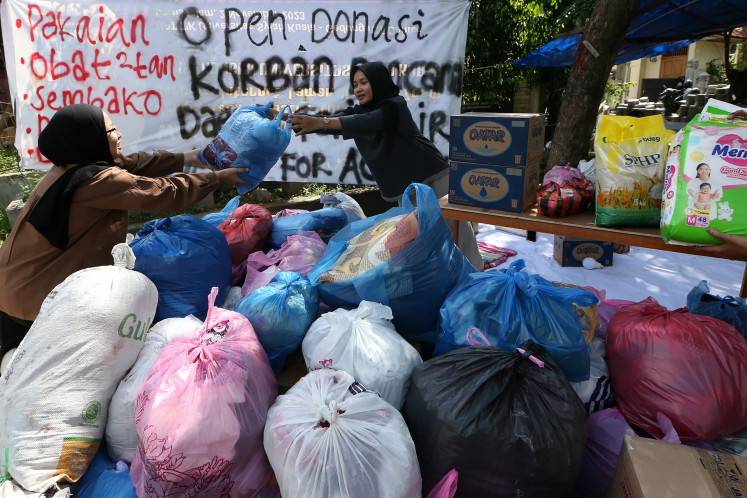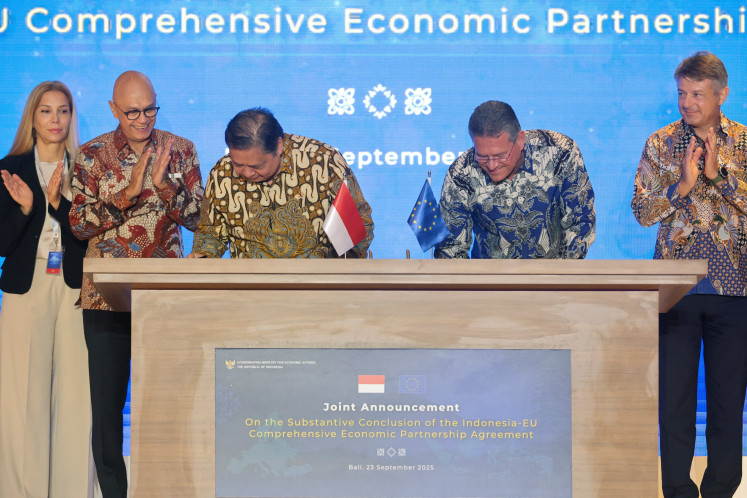Popular Reads
Top Results
Can't find what you're looking for?
View all search resultsPopular Reads
Top Results
Can't find what you're looking for?
View all search resultsBRIICs, world leaders in trade openness and growth
The world’s largest high-growth emerging economies are falling into the trap of protectionism amid the global crisis and they seem to forget that they have been prospering as a result of their relative openness to international trade and investment, according to an OECD report
Change text size
Gift Premium Articles
to Anyone
The world’s largest high-growth emerging economies are falling into the trap of protectionism amid the global crisis and they seem to forget that they have been prospering as a result of their relative openness to international trade and investment, according to an OECD report.
The report by the Organization for Economic Cooperation and Development (OECD) released in Geneva Thursday focuses on the world’s largest high growth emerging economies of Brazil, Russia, India, Indonesia, China and South Africa, which the organization calls the BRIICs.
The organization noted in the report that the mistaken notion that the current economic crisis was the result of free trade and market failure had led to an anti-market backlash and calls for protectionism, including among BRIIC countries.
Douglas Lippoldt, acting head of Development Division at the Trade and Agricultural Directorate at OECD, told reporters in Paris on Thursday that “times of crisis are also times of opportunities.”
“Trade protectionism is not the way to tackle the current crisis. All countries, including OECD members and BRIICs, should try more than ever to keep the international market open in order to improve economic prospects for all,” he said.
The report shows that all the six BRIIC countries were champions of free trade and market liberalization, but their openings to the market — except for China — have stalled.
In Indonesia, trade liberalization measures imposed by the International Monetary Fund following the financial crisis in 1997-98 have not been reversed, but there has been creeping protectionism in agriculture, textiles and steel, mainly through tariff barriers.
In Brazil, there was virtually no trade liberalization in the years since tariff reductions were introduced in the late 1980s and mid-1990s.
In South Africa, external trade liberalization has stalled since the 1990s and skepticism about liberalization has set in.
India is by far the most protected country among the BRIICs, with relatively higher average tariffs.
Russia is now in the process of accession to the WTO, but negotiations have been protracted and “stop-go” with no indications of being concluded in the near future.
OECD suggested that BRIICs pursue market openings through multilateral mechanisms under the WTO rather than through preferential free trade agreements because FTAs may only create complications for business and for the development of multilateral rules.
OECD also noted that these six BRIIC countries excelled in opening their borders to global trade, but were still struggling to liberalize their own domestic trade and investment, or what the OECD called the behind-border reforms.
Domestic reforms in service regulations, regulation of technical standards, intellectual property rights, public procurement rules, customs administration and competition rules are a key challenge in all the BRIIC countries.
In Indonesia, the biggest problems still include labor rigidity and impediments to investment, both domestic and foreign investment.
OECD picked these six emerging countries and made an update on them in this report on the BRIICs because of their growing and leading influence in the world economy.
The BRIIC concept is an extension of the idea of the original BRIC group. Goldman Sachs predicted that Brazil, Russia, India and China (the BRICs) would become a larger force in the world economy over the next 50 years and could become larger than the G6 (US, Japan, UK, Germany, France and Italy).
OECD then included Indonesia and South Africa in recognition of their economic size, relative to other OECD members.
Leaving aside oil-rich Saudi Arabia and two other large emerging OECD economies (Mexico and Turkey), the BRIICs are by far the largest economies in the developing world in transition, and the only countries in this category with gross national incomes of over US$200 billion per annum.










